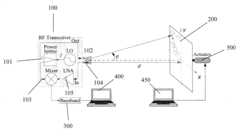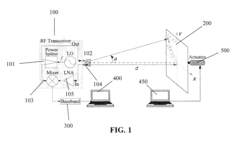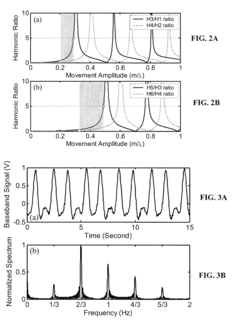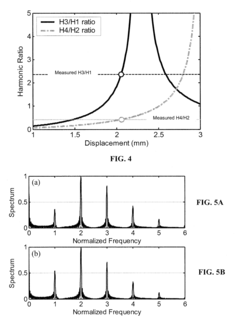Microwave And Millimeter-Wave Temperature Sensors - Eureka
Microwave and Millimeter-Wave Sensor Goals
Additionally, it aims to identify the major technical challenges and bottlenecks that currently hinder further progress in this domain. By analyzing the geographical distribution of relevant research and development activities, it seeks to shed light on the regional strengths and potential areas for collaboration or knowledge transfer.
Market Demand for Temperature Sensors
- Temperature Monitoring Applications
Microwave and millimeter-wave temperature sensors find applications in various industries, including:- Industrial process monitoring
- Environmental monitoring
- Biomedical diagnostics
- Automotive and aerospace
- Market Drivers
The demand for temperature sensors is driven by:- Increasing need for precise temperature measurement
- Adoption of automation and remote monitoring
- Growth of IoT and smart systems
- Stringent regulations and safety standards
- Market Segmentation
The temperature sensor market can be segmented based on:- Technology (microwave, millimeter-wave, infrared, etc.)
- Application (industrial, environmental, medical, etc.)
- End-use industry (manufacturing, energy, healthcare, etc.)
- Geography (North America, Europe, Asia-Pacific, etc.)
- Market Size and Growth
The global temperature sensor market is expected to grow significantly, driven by:- Increasing demand from various industries
- Technological advancements and product innovations
- Adoption of IoT and smart systems
- Stringent regulations and safety standards
Current State and Challenges of Microwave and Millimeter-Wave Sensors
- Technological Maturity
Microwave and millimeter-wave sensors have reached a relatively mature stage, with widespread applications in various fields such as remote sensing, radar systems, and telecommunications. - Key Challenges
- Signal attenuation and interference due to atmospheric conditions and obstacles
- Limited range and resolution compared to other sensing technologies
- Complex signal processing and data analysis requirements
- Geographical Distribution
The development of microwave and millimeter-wave sensor technology is concentrated in regions with strong research capabilities, such as North America, Europe, and East Asia.
Evolution of Microwave and Millimeter-Wave Sensing Technologies

Existing Solutions for Microwave and Millimeter-Wave Temperature Sensing
01 Millimeter Wave Body Temperature Measurement Devices
These devices utilize millimeter waves for non-contact body temperature measurement. They can be handheld or fixed, and analyze reflected or emitted radiation to determine temperature.- Millimeter Wave Body Temperature Measurement Devices: These devices utilize millimeter waves for non-contact body temperature measurement, designed as handheld thermometers or integrated into other systems.
- Microwave and Millimeter Wave Calorimetric Power Measurement: These systems and methods involve calorimetric techniques to measure the power of microwave and millimeter wave signals, used for calibration and measurement of low to medium power levels.
- Millimeter Wave Imaging and Sensing Systems: These systems utilize millimeter waves for imaging and sensing applications like security screening, object detection, and environmental monitoring, providing high-resolution images and data.
- Microwave and Millimeter Wave Circuit Components and Materials: These components and materials are designed for use in microwave and millimeter wave circuits and devices, including filters, oscillators, packages, and specialized dielectric materials.
- Microwave and Millimeter Wave Measurement and Testing Techniques: These techniques involve methods and apparatus for measuring and testing the performance of microwave and millimeter wave circuits, modules, and systems, used for calibration, characterization, and quality control.
02 Millimeter Wave Power Measurement and Calibration
These techniques involve measuring and calibrating the power of millimeter wave signals using calorimetric methods or specialized loads, important for applications like temperature measurement.03 Microwave and Millimeter Wave Temperature Sensing Materials
Specialized materials like low-temperature co-fired ceramics or magnetic compositions are developed for use in microwave and millimeter wave circuits and devices for temperature sensing applications.04 Millimeter Wave Imaging for Temperature Measurement
Millimeter wave imaging techniques can create temperature maps or visualize thermal patterns by employing millimeter wave sensors and imaging algorithms.05 Microwave and Millimeter Wave Circuit Packaging and Integration
These techniques involve packaging and integration of microwave and millimeter wave circuits and components, crucial for ensuring performance and reliability of temperature measurement systems.
Key Players in Temperature Sensor Industry
Robert Bosch GmbH
Tianjin University
Core Innovations in Microwave and Millimeter-Wave Sensing
- Detecting the phase shift caused by the movement of the target to measure displacement
- Developing a Doppler radar to monitor periodic vital sign movements
- Using a linear approximation to analyze the performance of the system
Potential Breakthroughs in Temperature Sensing
- Integrated CMOS Temperature Sensors
- Millimeter-Wave Radiometry for Non-Invasive Temperature Sensing
- Quantum Temperature Sensors










